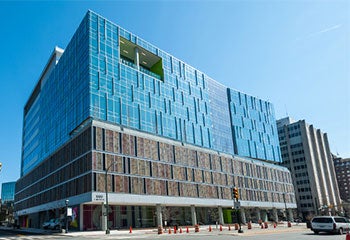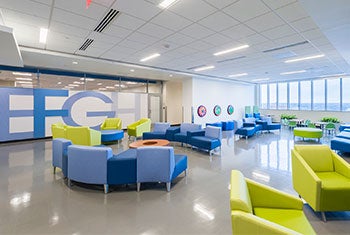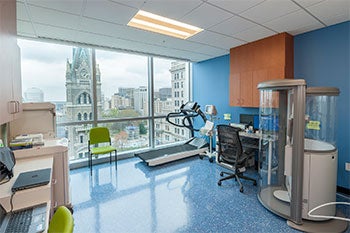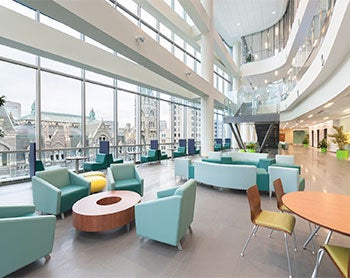New Children's Pavilion meets growing need in urban community
 |
| VCU University Relations The new ambulatory care center reaches 15 stories high, and consolidates several services. |
 |
| VCU University Relations Designers were inspired by natural elements, such as gardens and waterways, in their color selection. |
 |
| VCU University Relations Exam rooms are organized around the perimeter with a shared work core. |
 |
| VCU University Relations The sky lobby offers views of the city and connects to an outdoor terrace. |
The new state-of-the-art, 643,000-square-foot Children’s Hospital of Richmond at Virginia Commonwealth University (VCU) Children’s Pavilion will help the community meet the growing need for outpatient services for children.
Designed by HKS Architects Inc., Dallas, the 15-story, high-tech ambulatory pavilion consolidates existing pediatric clinics into a vertical urban pavilion. Skanska USA Building Inc., Nashville, Tenn., constructed the pavilion and JLL, Chicago, led project management.
The most advanced outpatient facility dedicated to children in the region, the pavilion includes a surgery level, three levels of pediatric clinics, a faculty/research floor and seven levels of parking.
Street-level viewers can gaze upward to see trees gracing the sky garden’s edges. Visitors enter a three-story atrium graced with a dramatic connecting stair on the second level that connects to the clinic floor above.
“Each step in the patient and family experience was designed to be enjoyable, welcoming and engaging,” says Leslie Hanson, AIA, principal, HKS.
“The sky terrace — located off the sky lobby — is a unique space in the city, bringing nature to the heart of the urban campus and providing views of Richmond’s historic Old City Hall and, beyond that, the Virginia state Capitol building, designed by Thomas Jefferson,” Hanson says.
On the sky terrace, interactive sculptures allow the kids to play music. Outdoor benches and seating areas — surrounded by native trees, indigenous plants and soothing chimes — provide patients, families and staff members with a quiet space.
The sky lobby connects to the expansive outdoor Sky Terrace equipped with an interactive play area. This area — as well as interactive art and sculptures — provides positive distractions for children and families. Kids can interact with a scene projected on the floor in the sky lobby as well as on the feature walls on Levels 2, 3 and 4.
The Ronald McDonald House Sibling Center, located in the sky lobby area, provides supervised activities and games for children awaiting their brothers and sisters who are receiving care in the clinic areas.
The new pavilion includes diagnostic and treatment services, consolidating the majority of outpatient pediatric services currently located on the VCU Medical Center Campus.
Designed to provide families the most advanced and coordinated care possible, the pavilion houses radiology, same-day surgery, lab testing, dialysis, infusions and more in an environment custom-made for kids, officials at Children’s Hospital of Richmond at VCU say.
Medical student education and clinical research studies also are included at the facility. It contains three levels of pediatric care clinics to include seven specialty clinic pods, each with 12 exam rooms, a treatment room, support spaces and a nurse work core.
The central work core enhances collaboration between nurses and physicians, resulting in a coordinated caregiver approach. Rather than embedding diagnostics into each specialty clinic, further efficiency is gained through shared diagnostics per clinical floor.
“Collaboration is key at the new pavilion,” says Laura Hild, IIDA, interior designer/vice president, HKS. “Specialty clinic modules are designed to optimize flexibility and efficiency while enhancing the patient experience.
“Each 12-exam module is organized with perimeter exam rooms surrounding a shared work core. This design creates a calmer patient experience by fully separating the offstage support zone from the onstage patient environment,” she says.
Concepts for the overall design, as well as detailed finishes, originate from nature as found in Richmond’s waterways, lush gardens and wooded land. The glass curtain wall reflects the sky and is illuminated in the sunlight in reference to the nearby James River.
"The Children's Hospital of Richmond at VCU Children’s Pavilion has been referred to as an oasis for children,” says Robert Reardon, chief facilities officer, VCU Health. The focus is on the patient and his or her family and the elimination of stressors associated with facilities in an urban environment, he adds.
Other details contributing to the soothing environment include stepped planters with native vegetation and brick-and-stone pavers that mimic the river's edge. Materials, colors and patterns found in nature are brought into the pavilion, blurring the lines between interior and exterior architecture.
Inside, a tile walkway creates a meandering path leading to key welcoming areas. Reflective glass used at strategic points throughout the building provides wayfinding cues for patients and visitors.
VCU Health is seeking LEED Silver certification for the project from the U.S. Green Building Council.
In other health care facility news:
-
Sacred Heart Health System held a groundbreaking May 3 for the new Studer Family Children’s Hospital, Pensacola, Fla., a four-story, 120,000 square-foot facility that will centralize and expand children’s health services.
The new hospital will be built on the grounds of the current hospital campus and connect to that facility. The new facility will allow staff to provide care for more children, and increase access to specialized pediatric and maternity care.
The facility will include a pediatric emergency department and trauma center, neonatal intensive care unit, pediatric oncology and extended stay/observation beds.
-
Caddis, a national health care real estate firm in Dallas, has opened Heartis Eagle Mountain, a 96-bed assisted living and memory care community in Fort Worth.
The 61,125-square-foot community includes 54 spacious assisted living units with 61 beds and a dedicated 35-bed memory care unit. The residence features a secure courtyard, walking paths and scenic views on a 4.3-acre site.
Want to see your new health care construction project featured on HFM Daily? Email project information and photos to Senior Editor Jeff Ferenc or tweet to him @JeffFerenc.

